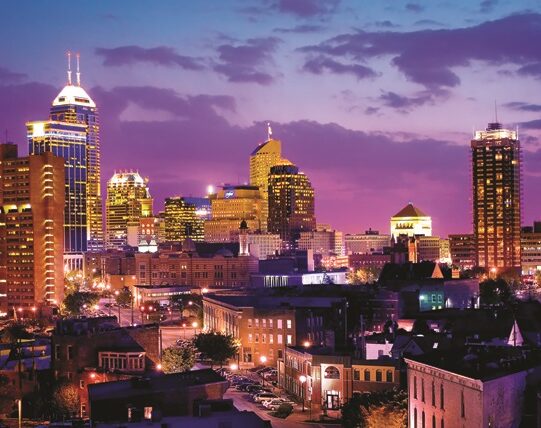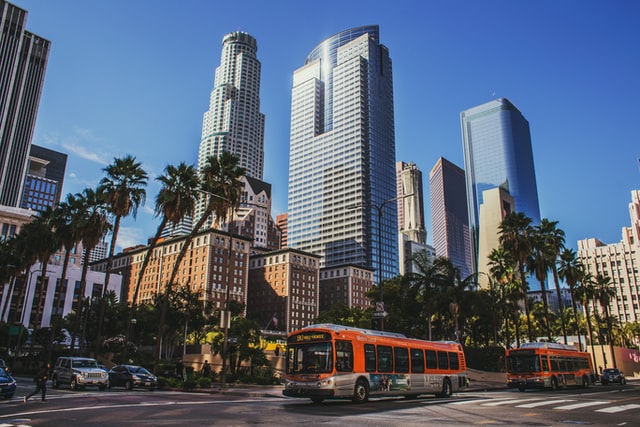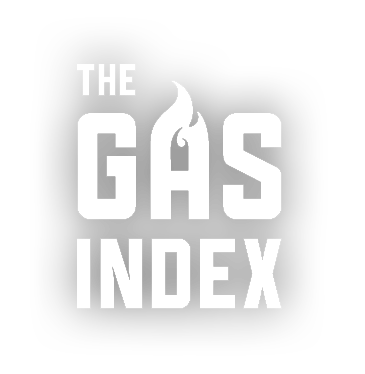
Case Studies
Indianapolis’ gas supply has the highest life cycle methane leakage rate of all cities evaluated in the Gas Index.
The city has been a testbed for a project called INFLUX, run by the National Institute for Standards and Technology (NIST), which has made multiple measurements of methane emissions within the city. One study of gas leaks in Indianapolis noted widespread enhancement of methane levels throughout the city, which “may be due to a widespread distribution of relatively small diffuse sources.
The available data indicate that more than half the methane emitted in the city originates from natural gas, and that approximately 2.5% of gas delivered to the city is leaking. This is a substantially higher leakage rate than estimated in the Gas Index model, based on properties of the local gas network and customer base, indicating the Gas Index model estimates were conservative. Therefore, the values for life cycle methane leakage for Indianapolis include a large contribution from “additional” emissions, based on the leakage measurement studies of the city.


Los Angeles
Los Angeles ranks #2 on the Gas Index, meaning the city’s gas supply is one of the leakiest in the U.S. The contribution from leakage within the city is about the same as leakage from outside the city, from leakage in production areas and from transmission pipelines.
Leakage within the city has been measured by a few different studies, covering the period 2007-2015, and which has included work by researchers at CalTech and the National Oceanic and Atmospheric Administration. These studies have consistently shown that substantial methane leakage from natural gas is occurring in the city.
Although there is some natural gas extraction within the wider Los Angeles urban area, studies have inferred that this extraction is a minor contributor to methane emissions in the city, and most of the leaks have been inferred to come from gas being delivered to customers in the city. The Gas Index model uses an average across studies that 1.7% of gas delivered to Los Angeles is leaking within the city.
Calculations by the Gas Index model based on the properties of the gas system in Los Angeles indicated substantially lower leakage rates than have been measured. This suggests that the Gas Index model values may be conservative, and also highlights the importance of measuring methane emissions in each city. (Most cities have not had the kind of methane emissions measurements that have been done in Los Angeles.) Because these citywide measurements indicated higher leakage rates than calculated by the Gas Index model’s usual methods, then the model assigns “additional” leakage to city’s gas supply.
Besides gas leakage within the city, the city’s gas supply also has leakage that occurs within production areas and from long-distance transmission pipelines. These sources of leakage would be more difficult for the city to address, since they occur far outside the urban area—with some of the leakage occurring from gas extracted in Canada.
Most of California’s natural gas production is in the San Joaquin Valley, which has the highest leakage rate of any production area evaluated in the Gas Index, which contributes to high leakage for California’s gas supply. California’s gas supply is mostly imported from other states or from Canada, and some of these states’ gas production areas have substantially higher leakage rates than the national average.
Also, for gas to reach Los Angeles, it has to travel on average about 1,200 miles through transmission pipelines, one of the longest transmission distances of any city evaluated in the Gas Index. The long transmission distances lead to more gas leakage along the route.
Phoenix
Phoenix ranks #3 on the Gas Index, indicating the city’s gas supply is one of the leakiest of any city evaluated. A major contributing factor to Phoenix’s ranking is the extensive gas distribution network in the city, with relatively long average pipeline length per customer and per unit of gas delivered. Longer pipelines mean more leakage, and these longer pipelines are likely related to the city’s sprawl.
In so far as sprawl contributes to gas leakage, it is a problem inherent to the gas network, and can’t easily be addressed by gas pipeline replacement programs. A major study of gas distribution mains published in 2020, and which the Gas Index draws on, found that even newer plastic pipelines still leaked methane at a substantial rate, which was much higher than the rate estimated in EPA’s Greenhouse Gas Inventory.
In addition to leakage from pipelines in the city, the Gas Index calculates that customer meters are a large contributor to Phoenix’s leakage. The southwest region has high leakage from customer gas meters, according to a 2019 study by the Gas Technology Institute that measured hundreds of meters across the country.


Boston
Boston was one of the first cities in the U.S. to be intensely scrutinized for methane leakage. Measurement surveys by scientists found extensive leakage from distribution pipelines under the city streets, apparently due to the city’s aging pipeline system. The attention to this problem grew following a series of explosions along gas pipelines in Massachusetts in 2018, which destroyed 40 homes.
The Gas Index Model estimates that 2.3% of gas is leaking within the Boston metro area (in addition to leakage that occurs before gas reaches the metro area). That value is driven largely by high leakage from distribution pipelines in the metro area, as the gas utilities themselves have reported to the U.S. Energy Information Administration. This high leakage appears to be due to having older pipelines, made of materials that suffer greater leakage.
The result from the model is similar to the leakage rate estimated from a detailed study led by Harvard University researchers for 2012–2013. That study used measurements from towers in and around the city to estimate that the city system was leaking 2.7% of gas brought into the city. A follow-up study through 2019 found slightly lower leakage rates, around 2.5%.
Boston’s gas supply is primarily from gas production in Pennsylvania, where production areas have the lowest leakage rate in the country. Also, because much of the gas comes from relatively nearby, the gas does not have to travel far, compared with the U.S. average, which reduces leakage from long-distance transmission pipelines.
Nonetheless, due to a high rate of leakage from distribution pipelines, the Boston metro area’s life cycle methane leakage is in the top 30% of all cities in The Gas Index.
New York City
New York City’s gas supply has the lowest methane leakage rate of any of the cities evaluated in the Gas Index.
One major contributing factor is where the city’s gas supplies come from. New York state gets most of its natural gas from Pennsylvania, which has relatively low leakage rate for the production stage. Also, since Pennsylvania is nearby, the gas does not have to travel far through transmission pipelines, leading to relatively low leakage from the transmission stage.
Another contributing factor is that the city is dense, so that relatively short pipeline lengths are needed to serve customers, and also each customer consumed a relatively high amount of gas on average. These factors mean the gas network operates relatively efficiently.
Nonetheless, New York City would still achieve substantial emissions reductions from switching buildings from gas heating to electric heating. Across all four scenarios in the Gas Index, the emissions savings from electrifying buildings in New York City ranged from 45% to 90%.
This is because New York state has relatively clean electricity already, and it is expected to get cleaner in the future—especially if the state remains on track to achieve its goal of 100% clean electricity by 2040, as required by the Climate Leadership and Community Protection Act passed in 2019.


